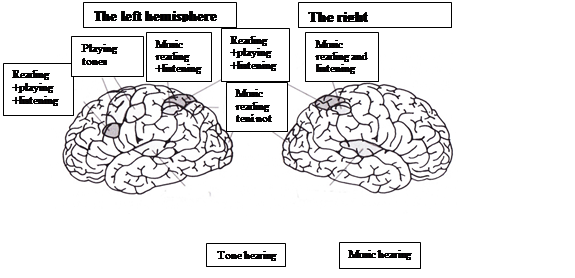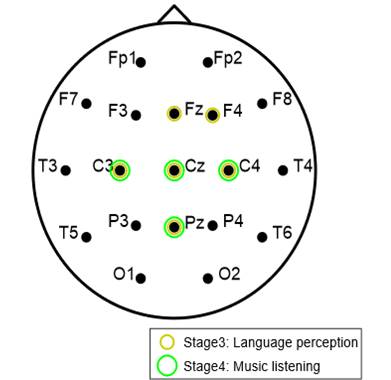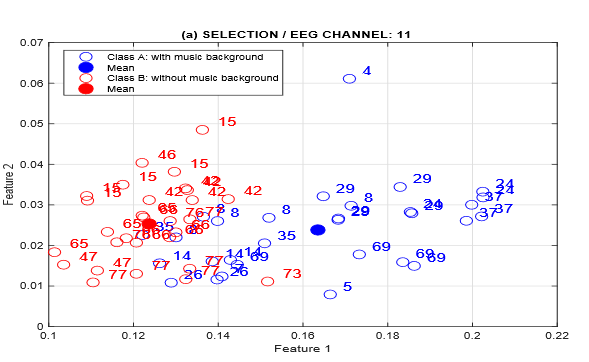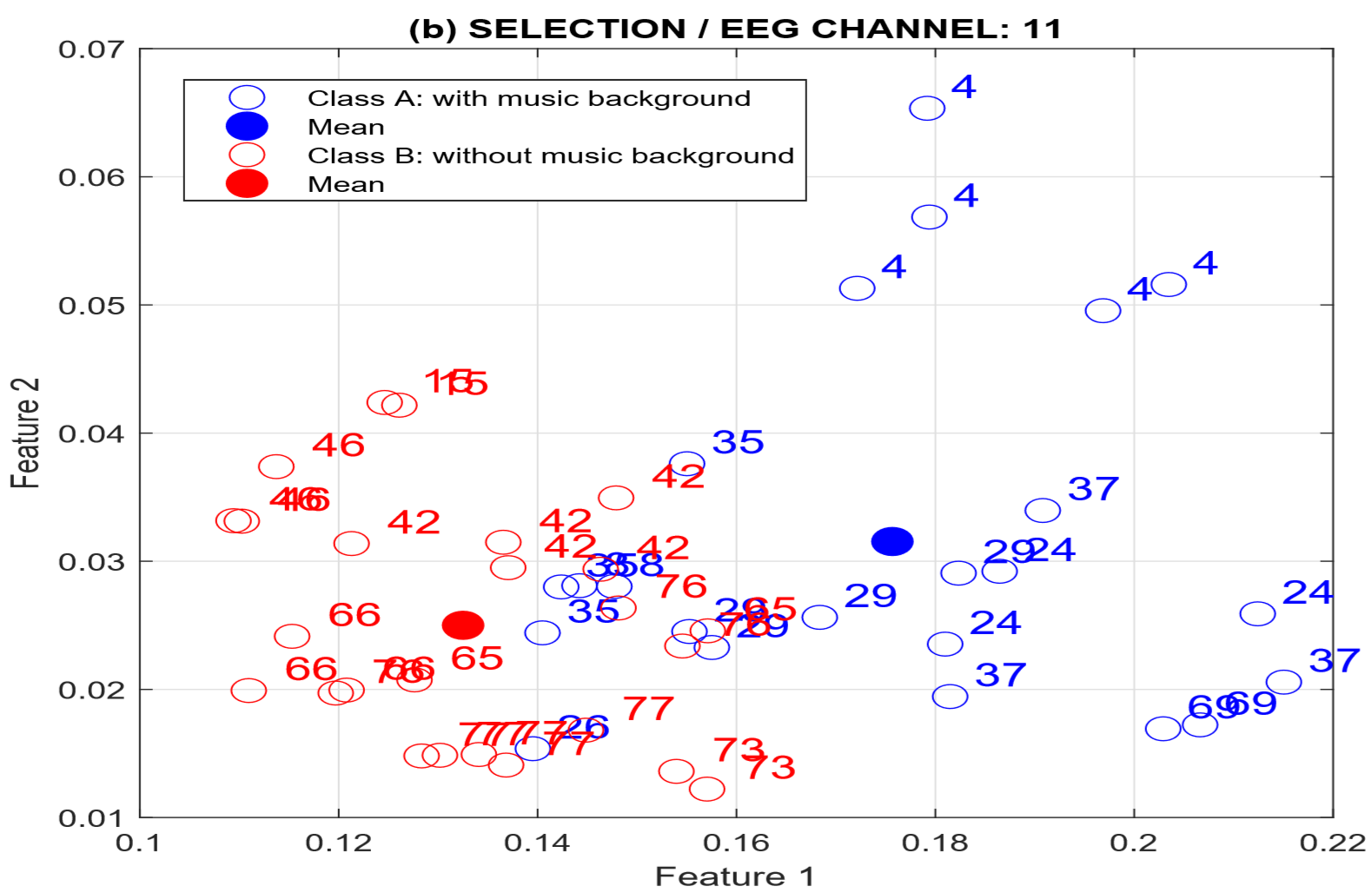Abstract
Music and language are inherently connected with human life. Music is a phenomenon present everywhere, and human beings are in permanent contact with music every day. Both the phenomena - music and language – are built on the strictly ruled bases and are firmly embedded in the human brain. Recent research has shown that the morphology of certain brain regions can actually correlate with a range of cognitive abilities such as musicality or speech ability. This paper presents the results of teamwork among linguists, neurologists and musicians, using an EEG study to identify differences when comparing the reactions of students with musical background and without musical background to incoming stimuli. The main intended outcome of studying these differences in terms of FLL was to confirm the fact, that the students with music background have a greater propensity to learn foreign languages. The set under study included 80 students who were subjected to an EEG while receiving different stimulus. Statistical and medical methods (such EEG) were used to detect the differences. The result showed a difference between students with musical background and without musical background where those with musical background appeared to react more extensively to the stimuli compared to those without musical background.
Keywords: Second-languageFLLmusicteaching methods
Introduction
The brain, the most important organ for controlling human bodies’ nervous system, consists of two hemispheres. These two brain hemispheres are not fully identical – numerous cases of research have proved that their form and size can be quite different. Until the 1970s, neurologists claimed that music and language were processed separately and in different brain hemispheres (see figure

This model has been overrun by more recent discoveries. During the recent decades, numerous research finding have brought the evidence of existing functional and structural differences between musicians and non-musicians.
For a very long time, it was claimed that the right hemisphere was connected with music whereas speech was localized in the left part of the brain. The most recent research proves that music is necessarily connected with both the brain hemispheres. The greatest contemporary experts in this sphere (compare Altenmüller, 2018; Jäncke, 2012; Spitzer, 2014, and others) claim that music and speech are anchored in the brain, and that there are certain transverse connections between both the hemispheres, among which there are numerous interactions. The scientific team chaired by Manuela Kerer (2009) claims that when a person is listening to music or is actively involved in music production, both his/her brain hemispheres are active. To make this claim more simplified, it can be said that according to Kerer (2009), melody and harmony are processed in the right hemisphere, but rhythm and pace in the brain’s left part (which is illustrated in Fig.

Concerning the perception of music, there has been a prevailing opinion that music is generally processed in the right part of the brain, whereas the special centres responsible for speech perception are located in the left part of the brain. The reality is, however, much more complicated. At this point it seems important to refer to Jäncke (2012), who mentions two prominent neuropsychologists, David Poeppel and Roberta Zatorre, who, independently of each other, pointed to the fact that one brain hemisphere processes acoustic stimuli differently from the other hemisphere. Simply said, both the neuropsychologists came to the same conclusion claiming that the left hemisphere specializes in analysing stimuli coming one after another at a fast pace, whereas the right hemisphere specialises in processing of frequency information (e.g. tone pitch). Applying this claim on human speech, we can say that when speech is being perceived, it is necessary to decrypt individual parts of the utterance, e.g. individual sounds, the voice pitch, the voice melody or the speech rhythm. At this point, Jäncke (2012) claims that individual sounds like consonants are recognized by the auditory cortex only in case when that particular auditory cortex is able to discern subtle differences in the sound current. The voice analysis is carried out dominantly in the left part of the brain. A kind of illustration of the brain’s processing of music and speech can be provided by some medical imaging methods, e.g. by the non-invasive method of examining the electric activity of the brain with the help of an electroencephalogram (abbreviated as EEG) or of functional magnetic resonance imaging (abbreviated as FMRI), which enable to map the brain’s reactions to external and internal stimuli. Applying these imaging techniques, we can localize certain brain centres which process language and music perception.
One of the relatively new disciplines on the border of linguistics and other sciences, which started to develop in the second half of the 20th century, is neurolinguistics, which studies relations between language and brain processes which convey the language. Many studies have been devoted to language perception (Ondrakova, Tesar, & Pavlikova, 2017; Tauchmanová, 2016) and music listening (Adamos, Laskaris, & Micheloyannis, 2018; Kumagai, Arvaneh, & Tanaka, 2017). Some studies suggest that a long-term experience in music or a second language contributes to enhanced cognitive functioning (Besedova, 2016).
Unlike psycholinguistics, neurolinguistics explicitly describes anatomic and physiological aspects of the human brain. Neurolinguistics is dominantly a medical doctors’ domain; it still has not attracted linguists’ deserved interest. Neurolinguistic issues are solved by neurology and linguistics and also by numerous other disciplines, like psychology, physiology, pedagogy or phoniatrics, etc. Neurolinguistics obviously requires team work of experts in several branches, and it is definitely not easy to organise such a kind of cooperation since these different branches have different specific features and methodology and different research objectives. The fact that such a team came into being in the town of Hradec Kralove, Czech Republic is a source of pride for everyone concerned. Linguists, psychologists and educationists from the Faculty of Education of the University of Hradec Kralove cooperated in this team with neurologists from the University Hospital Hradec Kralove and neurologists from the Faculty of Medicine of Charles University.
Problem Statement
Recent research has shown that the morphology of certain brain regions can actually correlate with a range of cognitive abilities such as musicality or speech ability. Music and language developments are inseparable from the overall development and harmonic cultivation of a human personality and they cannot be limited to a mere development of the anatomic-physiological system. Both music and language development of a personality must be connected with the other human qualities and with developmental changes in human psychical activities. The development of language and music competences is a varied summary of a human being’s somatic, neurophysiological, emotional and socio-cultural dispositions, with an obvious relationship between language and thinking and between music and thinking. The language and music developments of an individual being share numerous points, which can be identified during the mutual confrontation of both the variable.
The present paper is devoted to a computational analysis of the EEG signals acquired from different parts of the scalp to contribute to an understanding of the brain’s activities related to external stimuli, including language perception and listening to music. These correlations are evaluated for individuals with different musical experience. This research in perception of foreign language and music was deeply influenced by Pattel´s opinion (2008) “Humans are unparalleled in their ability to make sense out of sound. In many other branches of our experience (e.g., visual perception, touch), we can learn much from studying the behavior and brains of other animals because our experience is not that different from theirs. When it comes to language and music, however, our species is unique. This makes it difficult to gain insight into language or music as a cognitive system by comparing humans to other organisms. Yet within our own minds are two systems that perform remarkably similar interpretive feats, converting complex acoustic sequences into perceptually discrete elements (such words or chords) organized into hierarchical structures that convey rich meanings. This provides a special opportunity for cognitive science” (p. 3). What this means is that there is no doubt about the fact that the perceptions of language and music are connected;
Research Questions
The essential research question was: “Is there any difference that can be observed between FL students with musical background and those without musical background when their brain activity stimulated by listening to music and spoken word in their native language and a foreign language is being monitored?” Being aware of the fact that this issue involves a number of scientific disciplines, and that without the already mentioned collaboration of educationists, psychologists, linguists and neurologists this research would have been impossible.
Purpose of the Study
The neurophysiological essence of music and language is reflected also in certain points shared by both these phenomena. A significant source of findings in neurolinguistics is experimental research which applies electrophysiological and imaging brain methods, or methods of transcranial stimulation. The purpose of this study is to present the results of an EEG study which was carried out by collaborating experts from the Faculty of Education of the University of Hradec Kralove, from the Neurological Department of the University Hospital Hradec Kralove and from the Faculty of Medicine of Charles University in Hradec Kralove (Czech Republic). The main aim was to identify differences between students with musical background and those without musical background to incoming stimuli. This identification is expected to be fruitful for the sphere of methodology of foreign languages. This fruitfulness is connected with the fact that even elderly students of foreign languages appreciate involvement of songs in their foreign languages courses. The awareness of brain reactions to stimuli can help reveal successful teaching strategies and, as Tauchmanova (2016) says “Foreign language teachers should be able to anticipate difficulties, they should be also able to use potentials of positive transfers and think about convenient ways of teaching. Then a more effective teaching – learning process can be expected.”
Research Methods
The main method used to provide the data for this paper was the EEG method, used mainly in neurology, which was statistically evaluated using Factorial ANOVA, MANOVA methods of logistic regression. Before carrying out this research, the following hypotheses were formulated to be verified:
H1: The brain activity of those with musical background is different from those without musical background when reacting to coming stimuli.
H2: The brain activity of those with musical background to a stimulus in a foreign language is more extensive than those the brain reaction of those without musical background.
80 students of the Faculty of Education of the University of Hradec Kralove, Czech Republic, were involved in this research. 2 homogenous groups were formed: a) students with musical background and b) those without musical background.
The study mainly looked at the brain activity of respondents with 4 different stimuli and the research design included the following steps:
EEG monitoring
Resting EEG – 5 minutes,
Native language (Czech language) – 5 minutes,
Foreign language (German language) – 5 minutes,
Music – 5 minutes
The study was not primarily focused on understanding of foreign language, but on the response of the brain to given languages (Czech and German) and music by individual respondents.
Findings
According to Besedova (2017), the involvement of music in foreign language teaching can be understood from several points of view, mainly that of motivation, language reception and production, emotions and support given to intensive language perception. All these factors have an impact not only on the recipient, i.e. a foreign language learner, but also on the foreign language teacher. That is why the issue of the importance of involvement of music in foreign language teaching should be emphasised even in undergraduate teachers’ training. This opinion is supported by Ondrakova et al. (2017): “Not only the teacher’s linguistic knowledge is important; his/her pedagogical-psychological knowledge and professional experience is essential as well. The ways of educating and training future teachers are fully decided by teacher training colleges and institutions.”
For the purpose of this research, the standard non-invasive sensing EEG method was used - a functional examination of the electric activity of the central nervous system, when the summation signals from the neurons are being sensed with the electrodes from the surface of the scalp. Figure

A typical EEG alpha activity’s course was monitored; the frequency was approximately 12Hz. Every individual experimental session took 20 minutes; the persons were tested with their eyes closed. For the first 5 minutes, a recipient’s resting EEG was recorded, then the recipient listened to a 5-minute music recording followed by a 5-minute recording in German, for the last 5 minutes the recipient listened to a recording in Czech, the native language. A random choice of the recordings was used.
The ANOVA and MANOVA statistical methods were used to analyse the results. Figure

To provide a kind of comparison, Fig.

Conclusion
Music significantly impacts the life of human beings particularly in the physiological-psychological aspect, which refers to music’s impact on a human being’s neuropsychological system. This paper presents a comparative study of mental stage classification based upon the analysis of multichannel EEG signals for individuals with different musical backgrounds. The results point to EEG channels with the highest correlation of language and music perception with brain activity. The results of the study verified the first hypotheses; that brain activity is different between students with musical background and those without musical background when reacting to coming stimuli. Hence, it can be said that brain reaction of students with musical background to a stimulus in a foreign language is more extensive than brain reaction of those without musical background, thus confirming the second hypotheses
Human beings carry out numerous activities during their life as they develop, and a lot of these activities can be considered as being preparatory for the subsequent stages of life. Music and language play one of the most essential roles in human beings’ life. Mutual interconnections of music and language with other human activities bring a kind of enjoyment, as these interconnections cultivate human beings’ perspectives of the world while supporting human perception itself. Music as well as literature improves critical thinking skills, our creativity and stimulates our imagination (Heinrichova, 2017). Music and language development is a substantial component of a person’s harmonic development which is closely connected with building of the mental abilities, sensomotoric reactions, recognition and intellectual processes, with the development of the person’s ideas, phantasy, memory and overall sensibility. The development of language and music competences represents a diverse summary of somatic, neurophysiological, emotional and socio-cultural dispositions of a person; obvious relations between language and thinking and between music and thinking are quite evident here.
The main intended outcome of studying these differences in terms of FLL was to confirm the premise, that the students with music background would seem to have a greater propensity to learn foreign languages compared to those who don’t. This finding can be an important advantage for FL teachers, who can incorporate music into their FLT techniques in order to optimise the FL learning experiences for their students.
Acknowledgments
At this point the author thanks all the respondents who voluntarily participated in this research study which was approved by the ethics commission of the University Hospital Hradec Kralove, Czech Republic, and was carried out in accordance with all the rules of the ethics standards. Sincere thanks are also due to everyone who voluntarily processed the EEGs.
References
- Adamos, D., Laskaris, N., & Micheloyannis, S. (2018). Harnessing functional segregation across brain rhythms as a means to detect EEG oscillatory multiplexing during music listening. J. Neural Eng., 15(3), 036012.
- Altenmüller, E. (2018). Vom Neandertal in die Philharmonie. Warum der Mensch ohne Musik nicht leben kann. Berlin: Springer.
- Besedová, P. (2017). Ways of working with music in FLT in primary schools. The European Proceedings of Social and Behavioural Sciences, 31, 29-42. https://dx.doi.org/10.15405/epsbs.2017.10.4
- Besedová, P. (2016). Music as an intercultural medium in foreign language teaching. The European Proceedings of Social and Behavioural Science, 16, 646-662. https://dx.doi.org/10.15405/epsbs.2016.11.68
- Jäncke, L. (2012). Macht Musik schlau? Neue Erkenntnisse aus dem Neurowissenschaften und der kognitiven Psychologie. Bern: Hans Huber Berlag.
- Heinrichova, N. (2017). Teaching history through German literature. In: The European Proceedings of Social and Behavioural Sciences, 31, 184 – 193. https://dx.doi.org/10.15405/epsbs.2017.10.17
- Kerer, M. (2009). Demenz und Musik. Neuropsychiatrie, 23(1/2009), 9-14.
- Kumagai, Y, Arvaneh, M., & Tanaka, T. (2017). Familiarity Affects Entrainment of EEG in Music Listening. Front. Hum. Neurosci, 11(384), 1–384.8.
- Ondrakova, J., Tesar, L., & Pavlikova, A. (2017). Errors through the Eyes of Students Majoring in Teaching of Foreign Languages. The European Proceedings of Social and Behavioural Sciences, 31, 61-70. https://doi.org/10.15405/epsbs.2017.10.7
- Patel, A. D. (2008). Music, Language, and the Brain. Oxford University Press: Oxford, New York.
- Spitzer, M. (2014). Musik im Kopf. Hören, Musizieren, Verstehen und Erleben im neuronalen Netzwerk. Stuttgart: Schattauer.
- Tauchmanova, V. (2016). The Impact of the First Foreign Language on Another Foreign Language. The European Proceedings of Social and Behavioural Sciences, 16, 558-565, https://dx.doi.org/10.15405/epsbs.2016.11.57
Copyright information

This work is licensed under a Creative Commons Attribution-NonCommercial-NoDerivatives 4.0 International License.
About this article
Publication Date
14 January 2019
Article Doi
eBook ISBN
978-1-80296-052-5
Publisher
Future Academy
Volume
53
Print ISBN (optional)
-
Edition Number
1st Edition
Pages
1-812
Subjects
Education, educational psychology, counselling psychology
Cite this article as:
Besedova, P. (2019). The Anatomical Foundations Of Music Perception By Non And Foreign Language Learners. In Z. Bekirogullari, M. Y. Minas, & R. X. Thambusamy (Eds.), ICEEPSY 2018: Education and Educational Psychology, vol 53. European Proceedings of Social and Behavioural Sciences (pp. 104-112). Future Academy. https://doi.org/10.15405/epsbs.2019.01.10

